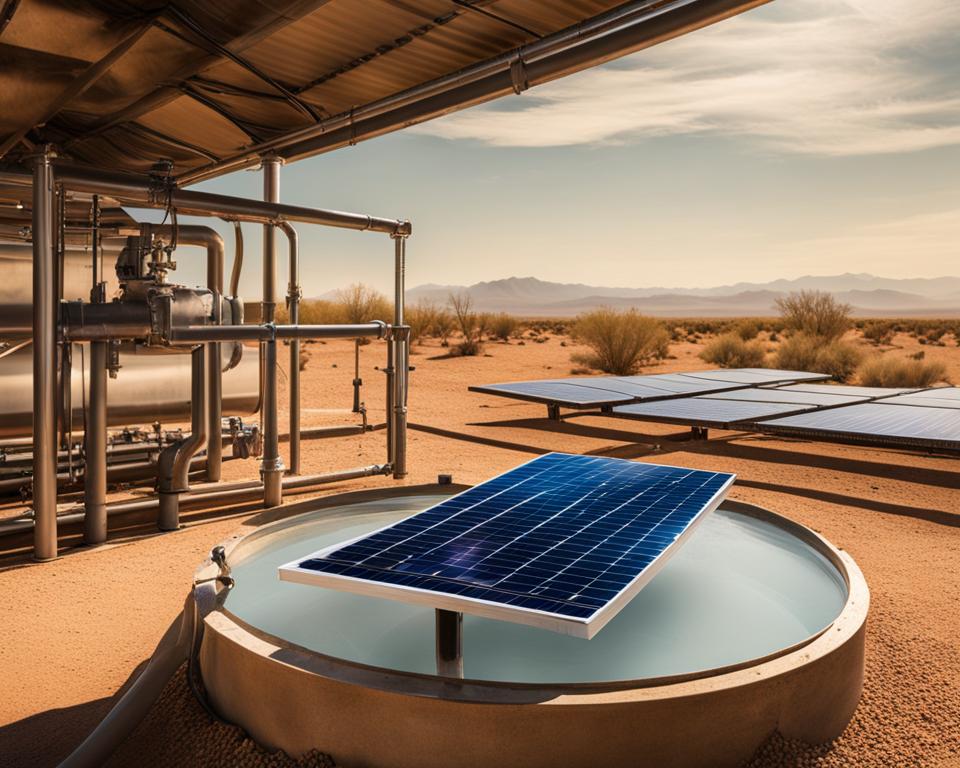Water scarcity is a growing concern worldwide, with many predicting that 87 countries will face water scarcity by 2050. To combat this problem, innovative water extraction techniques have been developed. These techniques utilize various methods to extract water from the air, such as atmospheric water generators (AWG) that use condensation to collect liquid water. Other methods include the use of desiccants and pressure. These technologies are crucial for areas where access to clean drinking water is limited.
Key Takeaways:
- Water scarcity is a global concern, with 87 countries predicted to face water scarcity by 2050.
- Innovative water extraction techniques have been developed to address the problem of water scarcity.
- These techniques involve extracting water from the air using methods such as condensation, desiccants, and pressure.
- Atmospheric water generators (AWG) are an example of a technology that uses condensation to collect liquid water.
- These innovative techniques are crucial for areas where access to clean drinking water is limited.
How to Extract Water from the Air
Water-from-air devices, also known as atmospheric water generators (AWG), are revolutionary inventions capable of extracting potable water from the ambient air. These devices utilize innovative methods similar to air conditioners to condense water vapor and collect liquid water for drinking and other purposes. One of the key components in these devices is the heating/cooling coils, which cool the air below the dew point of water vapor, causing condensation to occur and water droplets to form.
The process begins with the intake of air, which is then cooled by the coils. As the air cools, the moisture in the air condenses and the water droplets are collected. This condensed water is then filtered and treated to remove any impurities, ensuring that the extracted water is clean, safe, and ready for consumption. Some water-from-air devices also utilize desiccants or pressure to extract moisture from the air and generate usable water.
These water-from-air devices are especially valuable in areas with limited access to clean drinking water. They provide a sustainable and efficient solution to address water scarcity, as they can operate even in arid climates where traditional water sources are scarce. By harnessing the natural moisture present in the air, these devices offer a reliable source of clean water for communities in need.
Comparison Table: Water-From-Air Devices vs. Air Conditioners
| Water-From-Air Devices | Air Conditioners |
|---|---|
| Designed to extract water vapor from the air and generate potable water | Designed to cool or heat the air in indoor spaces |
| Utilize heating/cooling coils to cool the air below the dew point and collect water droplets | Use evaporator coils to cool the air and extract moisture, which is then drained away |
| Water droplets are collected, filtered, and treated for safe consumption | Moisture is removed from the air and drained away as condensate |
| Provide a sustainable source of clean drinking water in areas with water scarcity | Regulate indoor temperature and humidity for comfort |
As shown in the comparison table above, water-from-air devices and air conditioners have distinct purposes and functionalities. While both devices involve the cooling of air, water-from-air devices are specifically designed to extract moisture and generate potable water, while air conditioners focus on regulating indoor temperature and humidity.
With advancements in technology, water-from-air devices have become increasingly efficient and accessible. These devices offer a promising solution to combat water scarcity and provide clean drinking water to communities in need. By leveraging the natural moisture in the air, these innovative devices contribute to sustainable water extraction and resource management.
Ancient Water-from-Air Techniques
Ancient civilizations have long utilized ingenious methods to extract water from the air, showcasing their resourcefulness in combating water scarcity. One such example is the Inca water collection technique, practiced by the Inca civilization. These ancient people collected dew by strategically positioning large rocks to guide the condensation into cisterns. This allowed them to collect and store water for later use in areas with limited rainfall.
Another remarkable ancient technique is the concept of “air wells.” These passive structures were designed to capture and collect moisture from the air without the need for external power or moving parts. Air wells consisted of underground chambers with vents at the top, which allowed air to flow through. As the air cooled inside the chambers, water vapor condensed, dripped, and was collected at the bottom for use.
The implementation of these ancient water-from-air condensers demonstrates the ability of early civilizations to adapt and find innovative solutions to overcome water scarcity challenges. The knowledge and techniques developed by these civilizations can provide valuable insights for modern-day water extraction technologies.
Ancient Water-from-Air Techniques Table
| Ancient Technique | Description |
|---|---|
| Inca Water Collection | The Inca civilization collected dew by strategically positioning rocks to guide condensation into cisterns. |
| Air Wells | Passive structures that captured and collected moisture from the air without the need for external power or moving parts. |
Nature-Inspired Water Extraction
Nature has always been a source of inspiration for innovation, and when it comes to water extraction, it is no different. One fascinating example is the desert beetle, found in the arid Namib Desert. This beetle has evolved a clever technique called “fog basking” to extract water from the air. By positioning itself in an optimal angle to capture morning fog, the beetle’s shell condenses moisture, which then flows down to its mouth. Scientists have studied the beetle’s anatomy and surface texture to replicate its water-trapping capabilities using 3D printing technology.

The concept of biomimicry, which involves emulating nature’s designs and processes to solve human problems, underlies this research. By mimicking the beetle’s unique surface texture and optimizing the design, scientists aim to develop a passive and efficient method of extracting clean water. This nature-inspired approach holds great potential for addressing water scarcity in regions where access to fresh water is limited.
Nature’s Solutions through Biomimicry
Biomimicry is more than just replicating nature’s designs; it involves understanding the principles and strategies that enable organisms to thrive in their environments. By studying the strategies employed by various organisms, scientists can gain insights into solving complex engineering challenges, such as water extraction. In the case of the desert beetle, scientists are not only inspired by its water-trapping abilities but also by its ability to survive in extremely arid conditions.
Potential Applications of Biomimicry in Water Extraction
Biomimicry has the potential to revolutionize the field of water extraction. By drawing inspiration from nature’s solutions, scientists can develop innovative technologies that are efficient, sustainable, and cost-effective. These technologies could be used in various settings, from individual households to large-scale water treatment facilities, providing access to clean water where it is needed most.
| Advantages of Biomimicry in Water Extraction | Potential Biomimetic Solutions |
|---|---|
| Improved water collection efficiency | Replicating the structure of plant leaves that efficiently capture and channel water |
| Energy-efficient extraction methods | Mimicking the mechanisms used by animals to extract water from the air |
| Scalable and adaptable solutions | Studying the strategies employed by various organisms in different environments |
| Sustainable and environmentally friendly | Developing technologies that minimize water waste and use natural processes |
Innovative Water-from-Air Technologies
As the global water crisis intensifies, innovative technologies are emerging to extract water from the air and provide precious drinking water. These technologies leverage solar power, nanotechnology, and bioaugmentation to purify water and enhance sustainability. Let’s explore some of the most promising advancements in water-from-air extraction:
Solar-Powered Water Filtration
One of the most exciting developments in water extraction is the use of solar-powered filtration systems. These systems employ a gel that absorbs water, which is then purified using the energy from the sun. By harnessing renewable solar power, these devices provide clean drinking water while minimizing environmental impact.
Desalination Systems
Desalination systems have long been used to extract freshwater from saltwater. Recent advancements in membrane technology have made these systems more efficient and cost-effective. Desalination allows for the utilization of abundant seawater resources, expanding access to clean water in coastal regions where freshwater scarcity is a pressing concern.
Nanotechnology and Bioaugmentation
Nanotechnology-based water purification systems, such as carbon nanotube filters, offer a molecular-level approach to remove contaminants from water. These advanced filters exhibit impressive efficiency in eliminating various pollutants, ensuring water safety. Bioaugmentation, on the other hand, employs microorganisms to treat wastewater and transform it into drinking water, offering a sustainable and eco-friendly solution.
Acoustic Nanotube Technology, Photocatalytic Water Purification, and Automatic Variable Filtration are other groundbreaking techniques with immense potential in water-from-air extraction. These innovations aim to improve water quality and address the clean water crisis, providing hope for a sustainable and water-secure future.

Water Extraction for Water Scarcity Solutions
The clean water crisis is a global concern, with over 2 billion people lacking access to clean water. As populations grow and climate change intensifies, this crisis is expected to worsen. Water extraction techniques and technologies play a crucial role in addressing this issue. These innovative methods can provide sustainable solutions to ensure access to clean water for communities that need it most.
One key aspect of addressing the clean water crisis is the development of advanced water sanitation systems. These systems utilize various water purification technologies to remove contaminants and ensure that the water is safe for consumption. Nanotechnology-based purification systems, for example, use carbon nanotube filters to remove contaminants on a molecular level, providing clean and safe drinking water. These modern technologies are essential for improving sanitation and hygiene in areas with limited access to clean water.
Advancements in Water Purification Technologies
Advancements in water purification technologies have made it possible to treat contaminated water and make it safe for drinking. Solar-powered filtration systems are one such innovation. These systems use the sun’s energy to power the filtration process, providing a sustainable and efficient method of obtaining clean water. Desalination systems have also become more advanced, allowing for the extraction of freshwater from saltwater sources. Improved membrane technology has made desalination more cost-effective and energy-efficient.
Furthermore, bioaugmentation is another emerging technology that utilizes microorganisms to treat wastewater and transform it into drinking water. This process not only helps in water purification but also reduces the environmental impact of wastewater discharge. By harnessing these innovative water extraction technologies, communities can secure access to clean water, improving their overall quality of life.
| Technology | Function |
|---|---|
| Solar-powered filtration | Utilizes solar energy to power the filtration process, making water safe for drinking. |
| Desalination systems | Extracts freshwater from saltwater, using advanced membrane technology to make the process more efficient. |
| Nanotechnology-based purification | Removes contaminants on a molecular level, ensuring clean and safe drinking water. |
| Bioaugmentation | Uses microorganisms to treat wastewater and transform it into drinking water, reducing environmental impact. |
These water extraction technologies not only address the immediate need for clean water but also contribute to long-term solutions for water scarcity. By implementing these innovations, communities can improve water access, sanitation, and overall hygiene, ensuring a healthier and more sustainable future for all.
The Future of Water Extraction
As the world grapples with the growing challenge of water scarcity, the future of water extraction is being shaped by innovative technologies and advancements in wastewater treatment, sanitation, and hygiene. The urgency to find sustainable solutions is crucial as the global clean water crisis worsens, impacting billions of lives.
Innovations in Water Extraction Technologies
Researchers and engineers are constantly exploring new avenues to improve water extraction methods. Future water extraction technologies aim to optimize efficiency, reduce energy consumption, and enhance the overall sustainability of the process. One area of focus is the development of advanced filtration and desalination systems that can effectively remove contaminants and transform seawater into potable water.
Another promising avenue is the integration of nanotechnology into water extraction processes. Nanomaterials, such as carbon nanotubes, offer enhanced filtration properties and can selectively remove pollutants. These advancements have the potential to revolutionize water extraction and ensure access to clean water for communities around the world.
Advancements in Wastewater Treatment
Efficient wastewater treatment plays a vital role in water extraction efforts. The development of innovative treatment technologies can help transform wastewater into a valuable resource. This includes the extraction of usable water, as well as the recovery of valuable materials and energy from wastewater streams.
Sanitation and hygiene practices are also critical aspects of the future of water extraction. Improved sanitation infrastructure and education can reduce the burden on water resources by minimizing water wastage and contamination. By prioritizing proper sanitation and hygiene practices, we can ensure the availability of clean water for generations to come.
| Future Water Extraction Technologies | Key Features |
|---|---|
| Solar-powered filtration | Utilizes solar energy to power water purification processes, reducing reliance on electrical grids. |
| Membrane desalination | Advanced membrane technologies that efficiently remove salt and impurities from seawater. |
| Nanotechnology-based filtration | Harnesses the unique properties of nanomaterials to selectively remove pollutants and contaminants. |
| Wastewater recovery systems | Extracts usable water, valuable resources, and energy from wastewater streams. |
The future of water extraction lies in driving forward these technological advancements, coupled with a global commitment to prioritize sustainable water management. By investing in research, innovation, and infrastructure, we can create a future where clean and accessible water is available to all, ensuring a healthier, more sustainable planet.
Leveraging Water Extraction for Sustainable Resource Management
The importance of water extraction techniques extends beyond addressing water scarcity; it also plays a vital role in sustainable resource management. These innovative methods can be applied across various industries, including water damage restoration and resource management, to promote sustainability and efficient utilization of water resources.
In the field of water damage restoration, advanced water extraction equipment is crucial for minimizing damage and waste. By swiftly removing excess water and drying affected areas, these technologies help prevent further structural damage and the growth of mold or other harmful contaminants. This not only saves valuable resources but also ensures a safe and healthy environment for building occupants.
Furthermore, incorporating water extraction techniques into resource management practices can lead to more efficient utilization of this precious resource. By recycling and reusing extracted water, industries can significantly reduce their reliance on freshwater sources. This sustainable approach not only conserves water but also minimizes the strain on ecosystems and reduces the carbon footprint associated with water consumption.
Embracing water extraction technologies as part of sustainable resource management strategies is crucial for addressing the global water crisis and ensuring a resilient future. By implementing these techniques, industries can contribute to a more sustainable and responsible use of water resources, helping to safeguard our environment and promote the well-being of communities worldwide.
FAQ
What are some innovative water extraction techniques?
Innovative water extraction techniques include atmospheric water generators, desalination systems, nanotechnology-based water purification, bioaugmentation, and acoustic nanotube technology.
How do water-from-air devices extract water from the air?
Water-from-air devices, such as atmospheric water generators, use condensation to collect water vapor from the air. They cool the air below the dew point of water vapor, causing it to condense and collect as liquid water.
Are there any ancient techniques for extracting water from the air?
Yes, ancient civilizations like the Incas used rudimentary techniques to collect dew and channel it into cisterns. Another ancient technique called “air wells” used passive methods to collect water with no external power source or moving parts.
Can nature inspire water extraction techniques?
Yes, nature can inspire water extraction techniques. For example, the desert beetle in the Namib Desert uses a technique called “fog basking” to extract water from the air. Scientists have studied this beetle’s anatomy to replicate its ability to trap moisture using 3D printing.
What are some innovative water-from-air technologies?
Some innovative water-from-air technologies include solar-powered water filtration, desalination systems, nanotechnology-based water purification, bioaugmentation, acoustic nanotube technology, photocatalytic water purification, and automatic variable filtration.
How can water extraction technologies help address the clean water crisis?
Water extraction technologies, such as water purification systems and desalination, can provide clean drinking water to communities that lack access. These technologies improve sanitation and hygiene, helping to address the global clean water crisis.
What does the future hold for water extraction?
The future of water extraction lies in ongoing research and development of advanced technologies. This includes advancements in wastewater treatment, sanitation, and hygiene to improve water extraction processes and address future challenges.
How can water extraction contribute to sustainable resource management?
By leveraging advanced water extraction equipment and techniques, industries can efficiently remove and dry water, minimizing damage and waste. This contributes to sustainable resource management efforts and promotes sustainability.

Leave a Reply